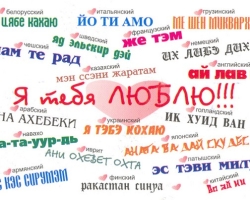What carries the newlyweds a leap year, the month of May and the rain at the end of the wedding day read with the article.
Content
The wedding in Russian culture from time immemorial was a key event in the life of every person. It was accompanied by special rituals, which were treated very seriously.
All Russian brides passed through a long string of all kinds of rites and one of them could not be neglected. Until now, the wedding celebration is accompanied by a certain number of traditional actions on which the existing and still wedding signs and superstitions are based. It is about them that we will talk about this article.

Wedding signs in a leap year
An amazing fact. The adjective "leaps -bubble" is used in combination with only one noun - "year".
Another amazing fact. The Christian church has no restrictions on marriage in the leap year. And all terrible stories, transmitted from mouth to mouth, condemns and refutes it as much as possible, considering it pagan superstitions.
Why do we not like the leap year for so much? And why is it considered a marriage this year is not the best idea?
This is how the leap year is described in the ancient annals:

Who is to blame for this?
February 29 is honored:
- in Christianity - the most unloved holy Kasyan mesy (crooked Kasyan)
- in paganism - the worst and most evil god of the Slavic pantheon - Kashchei (Chernobog)
Our ancestors said about the leap years and Kasyan as follows:
- Sleud of offspring in a leap year
- Kasyan all the scythe mows
- Beware Kasyanov's Eyes and Pipe voice
- Kasyan has a name day - happiness
It is not surprising that with this attitude to the disgraced saint, all year is considered extremely unsuccessful, especially for any undertakings. And since the wedding is a very important event for a future family tried not to celebrate Kasyanov for a year.

If the marriage was still inevitable, then there was a conspiracy that was supposed to protect the young eyes from Krivoy Kasyanov. In the church, before the wedding ceremony, young people should have pronounced the phrase: "I was married to a crown, not a leap end"
In addition, in the leap year, it was not customary to arrange magnificent wedding festivities.
Wedding signs by month
Surprisingly persistent dislike of the Russian wedding tradition for the month of May. Everyone, at least once in his life, heard the phrase: "In May to marry (be born) - to be all his life." But the May wedding signs have a very practical explanation.
Historical fact. The appearance of the word "May" in Russian we owe the Julian calendar. The original Russian name of this month is a herbalist, flowering.

The last month of spring was a month of active agricultural work. It was about this month that they said: "The year feeds." By May, the cattle exhausted during the winter had not yet had time to walk the meat in green meadows, and the bins of people were devastated.
The traditional Russian wedding was played for a week. All relatives gathered at the celebrations. So the whole family, walking at the wedding, missed the time for sowing and will interrupt-toil-all winter on meager reserves only because of the unsuccessfully chosen time to conduct the celebration.
Important: the Orthodox calendar considers May 22 - the day of the memory of St. Nicholas the Wonderworker - one of the most successful dates for the ceremony of the wedding.
Wedding signs on holidays
Among other dates that are especially allocated by the Orthodox calendar for the ceremony of the wedding:
- July 21 and November 4 - Honoring the icon of the Kazan Mother of God
- October 26 - Honoring the icon of the Iveron Mother of God
Wedding for baptism signs
Directly on the baptism of January 19, peculiar brides' brides were arranged. Girls in their best outfits gathered near the Jordan (hole) or in the square and exposed in a row, and young unmarried men chose a future wife among them.
At the same time, the future mother -in -law most often attended, which could afford not only to carefully examine the girl who had attracted his son, but also to touch her hands, checking the hot blood of the future daughter -in -law, to check the efficiency and novelty of the outfit.

The second day after baptism was opened by the very wedding period of the year - a winter weddingik or wedding. It lasted until the oil week and was considered the most successful for the start of marital life.
Wedding for Shrovetide signs
The Orthodox calendar does not welcome marriages during the raw divisions (cheese week). The main explanation is that this week involves preparing for a multi -day Easter post, the beginning of purification.

Interesting fact. The word "marriage" comes from the Slavic word "brisk", which means "feast".
Preparations for the post and the post itself imply a refusal not only of imminent food and visiting amusements, but also from marital relations. In addition, given the pagan character of Shrovetide, the Orthodox said that this week only walks.
At the same time, during the mosquito, who became the Slavic prototype of modern Shrovetide, it was customary to play weddings, because such unions were blessed by Veles - the god of fertility and good luck. And the most successful marriages were considered to be prisoners on the day of the solar equinox-March 21-22. On this day, the Slavs honored young Yarilo.
Red Hill Wedding
Red Gorka is another holiday in the Orthodox calendar with pagan roots. Before the baptism of Russia on the twenties of April, the second Yarilin day celebrated the second. Only now Yarilo was violent, that is, mature, filled with juices of life.
The name of the holiday is easily explainable: it was small hills - slides - dried the first under the rays of the gentle sun and were the best suited for youth festivities. And the “red” slide is because beautiful in fresh spring greenery. The red color of the Slavs was a symbol of beauty.

In the Orthodox calendar, Red Hill coincides with Fomin's day, completing the Easter week and opening the spring-summer wedding ward. This weddingshop continued to the Trinity. For this period, the largest number of weddings always had.
As a rule, pairs were crowned on a red hill, adjacent to the oily week.
Wedding on the red hill signs
The main sign of the wedding on the red hill is expressed by a folk proverb: "Whoever marries the hill on the red hill - that century will not be fired!"
Signs of weather at the wedding
Our ancestors lived in close unity with nature, learned to feel all its changes, predicted the future in the natural phenomena that occur during sign events in their lives.
The rain for the wedding is a very good sign. As the seed rushes, thrown into the ground and irrigated by the rain, so the wedding celebration will end with the emergence of a new life. In addition, rain at the end of the wedding day is able to wash off all the bad energy and future troubles.

What can not be said about a storm with thunder and lightning. Such a weather was a harbinger of difficult relationships in a young family.
A strong wind, of course, promised windiness in the relations of the newlyweds, possible treason and, accordingly, quarrels. The sun is joy and prosperity. Fog is an uncertain future in which there is nothing yet: neither bad nor good.
Snow promised fidelity and honesty, and a strong unexpected frost is the rapid birth of a first-a-man boy.
Wedding signs are our centuries -old heritage. And to believe in them or not is everyone’s personal business.







